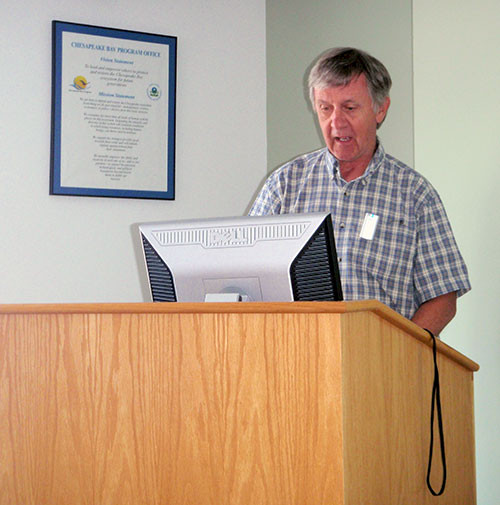Discussion following Walter Boynton's seminar on Where has all the nitrogen gone? Hot spots in the land and seascape
Bill Dennison ·This blog post discusses the seminar given by Walter Boynton of the Chesapeake Biological Laboratory, at the IAN Seminar Series on July 29, 2010.

The discussion focused on the bioavailability of nitrogen in its different forms. The dissolved inorganic nitrogen forms (e.g., nitrate and ammonium) were contrasted with dissolved organic nitrogen and particulate nitrogen. It is recognized that some fraction of dissolved organic nitrogen is bioavailable, but generally is not as immediately available as inorganic forms. Particulate nitrogen is only available for uptake by phytoplankton after decomposition.

Walter was asked about his method of estimating the nitrogen loading in pre-colonial times. His approach was to ask terrestrial ecologists what the nitrogen export was from unaltered mixed deciduous forests that they were studying. He was careful to select forests unaffected by acid rain, since anthropogenic inputs of nitrous oxides due to fossil fuel burning would inflate the nitrogen values. The 3-4 estimates converged to around 1 lb of nitrogen per acre per year. Walter then took the forested area of the watershed estimated by Grace Brush using palentological records and extrapolated accordingly.
The issue of the mid-Patuxent marshes holding their own against relative sea level rise was discussed. Walter noted that the Patuxent marshes have been intact since at least 1917. The salt marshes of the lower Patuxent River and Chesapeake Bay overall, in contrast, are eroding as a result of relative sea level rise. The difference in the tidal freshwater marshes could be due to the sediment accretion from both upstream but also local sources. Another factor was the sediment sizes--larger, coarse grained sediments are better for marsh accretion than fine, silt sized particles. In addition, it was noted that the undeveloped region surrounding the tidal freshwater marshes of the Patuxent River allows for channels to migrate and promotes natural hydrologic processes. In contrast, the salt marshes of the lower Patuxent River are largely constrained by development (e.g., hardened shorelines).
Walter discussed how the Patuxent compares to other Chesapeake tributaries. The Patuxent is one of few tributaries that did not have highly developed regions at the head of tide. In contrast, the Potomac River head of tide marshes have largely been replaced by what is now Washington, D.C. Walter likened the removal of these marshes to the removal of a nitrogen kidney. The Choptank River on the Eastern Shore has an undeveloped region at the head of tide similar to the Patuxent River. Both the Patuxent and Choptank Rivers have tidal freshwater marshes which remove substantial amounts of nitrogen, resulting in only 20 and 17% of the nitrogen inputs to be exported downstream. The Potomac River without these marshes exports 40% of the nitrogen inputs, twice as much as rivers with intact marshes. Walter is searching for nutrient budget data from other river systems with 'globs' of intact marshes to see if this nitrogen removal by marshes is generic.
The data Walter presented with a large divergence in nitrogen concentrations between incoming and outgoing tides was discussed. The rapid uptake (within one tidal cycle) was noted and contrasted to the relationship that Walter indicated between residence time (in days) and net denitrification. The relationship between residence time and denitrification is not necessarily a causal relationship--longer residence times could simply be regions that promote marsh accretion. Walter talked about the large areas of shallow water with dense vegetation with prolific bacteria and algae (where you can 'feel' photosynthesis) with the three conditions that promote denitrification: 1) abundant dissolved nitrate, 2) anaerobic (without oxygen) conditions adjacent to aerobic (with oxygen) conditions, and 3) labile organic material. The recommendation by Grace Brush to 'replumb' the watershed to emulate the wetter conditions that occurred when there were an estimated 5 million beavers in pre-colonial times was discussed. Walter related his experience in Calvert County when the first beavers returned and the news reports were about 'nature's engineers' and 'cute fur-bearing creatures', but after some time and more beavers causing local flooding, the reports became about the 'miserable overgrown rodents'. Beavers are now found in many protected areas on the western and eastern shores of Chesapeake Bay, but various measures apart from beaver dams need to be taken to emulate pre-colonial water retention. Several approaches were discussed, including stormwater ponds designed as wetlands and maintained properly. Walter noted that a group from University of New Hampshire tests various stormwater treatment technologies, with particular reference to technologies with longer lifetimes and less maintenance requirements. Walter indicated that he was unable to account for the high denitrification rates touted by floating island technologies.
The importance of light reaching the bottom, a topic of Walter's previous IAN seminar, was noted as helpful for denitrification--enhancing the oxidation of ammonium to nitrate which could then be denitrified. One of the features of tidal freshwater marshes is the very shallow water, allowing the aerobic/anaerobic interface in the sediments to be capped by benthic microalgae, which absorb dissolved nutrients in the sediments.
About the author
Bill Dennison

Dr. Bill Dennison is a Professor of Marine Science and Vice President for Science Application at the University of Maryland Center for Environmental Science.

